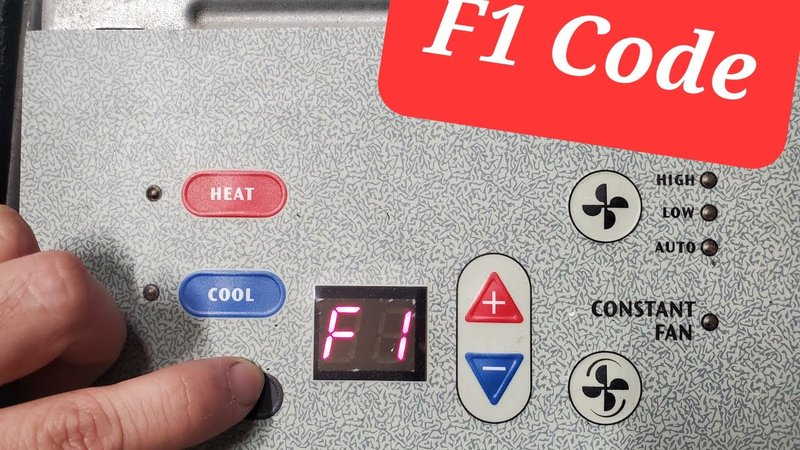
So, what’s the deal with this F1 error code? Essentially, this code is like your garbage disposal’s way of telling you it needs some attention. Think of it as a toddler tugging on your sleeve when they need help with something. In the case of garbage disposals, this code often points to an issue with the unit’s motor. The F1 error could indicate the motor is overloaded or overheating, much like when your laptop gets too hot and needs to cool down. Understanding what triggers this code is the first step toward getting your disposal back up and running.
Understanding the F1 Error Code
When your GE garbage disposal flashes the F1 error code, it’s attempting to communicate a problem, much like when your phone displays a low battery alert. This particular code is all about the motor, which is the powerhouse of your garbage disposal. If the motor encounters resistance — due to a blockage or attempting to grind something too tough — it can become overloaded. Imagine trying to ride a bike uphill with flat tires; it’ll be quite the struggle! Similarly, when the motor struggles, it can trip a safety switch to prevent any further damage.
If the F1 code appears, it means your disposal’s motor isn’t happy. This could be because it’s overheated after running for too long or because it’s trying to handle something it shouldn’t. For instance, fibrous foods like celery or potato peels can be surprisingly tricky for garbage disposals, much like trying to untangle a knotty shoelace. Recognizing what stresses the motor can help prevent these issues in the future.
To address an F1 error code, start by turning off the garbage disposal to allow the motor to cool down. Think of it as letting a stressed friend take a breather. Give it about 15-20 minutes, then try resetting it. Most disposals have a reset button on the bottom or back of the unit. This reset acts like a fresh start for the motor, much like rebooting your computer when it’s acting up.
Common Causes of the F1 Error
Now that we’ve covered what the F1 error code generally means, you might be wondering what typically causes it. One cause could be jamming, where something is stuck in the blades or in the grinding chamber. Imagine a piece of bone or a spoon caught between rotating parts — it makes the motor work extra hard, which can trigger the error.
Another potential cause is overheating, usually from overuse. If you’ve been running your disposal continuously for an extended period, it could overheat. The F1 error is essentially the disposal saying, “I need a break!” It’s a bit like when your smartphone gets too hot after streaming videos for hours; it just needs time to cool down.
Lastly, there’s the issue of incorrect usage. Sometimes, we might unknowingly put things down the disposal that aren’t suitable, like coffee grounds, eggshells, or grease. These items can build up and create a tough situation for your disposal to handle, leading to an F1 error. By being mindful of what goes down the drain, you can help prevent future problems.
Fixing and Preventing the F1 Error
Alright, you’re faced with the F1 error, and it’s time to roll up your sleeves and get to work. Start by ensuring the disposal is turned off. Safety first! Then inspect inside the disposal for any visible blockages. If you see something stuck, like a sneaky little piece of silverware, gently remove it with tongs or pliers. Never use your hands — think of it like reaching into a dark, mysterious hole; better safe than sorry!
Next, if the motor has simply overheated, let the unit cool for a while before trying to reset it. If the disposal still doesn’t work, you may need to check the circuit breaker, as a tripped breaker can cut power to your disposal unit. It’s like flipping the light switch back on after a power cut.
To prevent the F1 error from cropping up again, be mindful of what you’re tossing down the disposal. Remember, no fibrous, starchy, or greasy foods! Regular maintenance, like routinely running cold water through the unit for a minute after use, helps keep everything running smoothly. Think of it as giving your disposal a little rinse and refresh.
When to Call for Professional Help
Sometimes, despite your best efforts, the F1 error persists. It’s not a reflection of your skills — think of it like having a tricky math problem that just needs a fresh set of eyes. In such cases, calling a professional is the best course of action. They have the tools and expertise to diagnose and resolve more complex issues that you might not be able to handle on your own.
It’s important to know your limits; poking around inside an electrical appliance can be risky. If you’ve tried resetting, checked for blockages, and ensured the unit has cooled but the error continues, a professional can help pinpoint the exact problem. It’s a bit like calling in a mechanic when your car won’t start — they have the know-how to get things running again.
In the end, understanding the F1 error code is about getting familiar with your garbage disposal’s needs. By learning a bit more about what makes it tick (or not tick, in this case), you’re better equipped to keep it in peak condition. And remember, it’s always okay to call in the experts when things get tricky.
